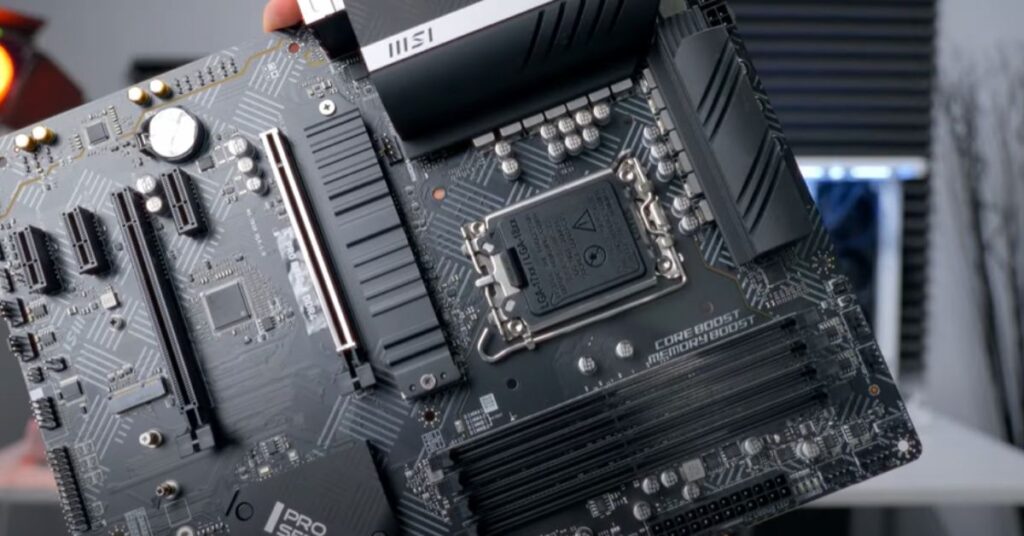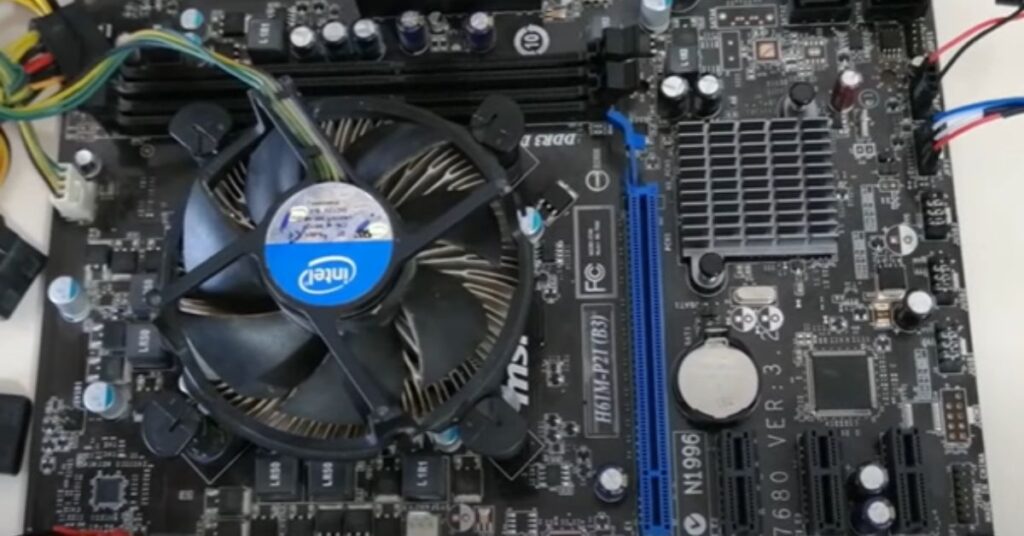Are you experiencing issues with your computer? Perhaps it’s refusing to power on, acting erratically, or displaying strange error messages. In such moments of frustration, one question might cross your mind: Can the motherboard be repaired?
Understanding the repairability of a motherboard is crucial for anyone facing technical issues with their computer. Motherboards are the backbone of your system, connecting all components and ensuring smooth operation. When they malfunction, it can disrupt your entire computing experience.
Table of Contents
Common Motherboard Issues
Despite playing a vital role in computer systems, motherboards can develop several problems for a variety of reasons. Gaining knowledge about these typical problems will enable you to diagnose problems more accurately and decide whether motherboard repair is required.

Here are some typical issues you might encounter:
- Faulty Capacitors: Capacitors on the motherboard can fail over time, leading to issues such as instability, power failures, and system crashes. Signs of faulty capacitors include bulging or leaking electrolytic fluid.
- Broken Connectors: Connectors for components like USB ports, audio jacks, and expansion cards can become damaged or loose, resulting in connectivity problems or complete failure of the affected ports.
- BIOS Corruption: Corruption of the Basic Input/Output System (BIOS) can occur due to various reasons, such as improper flashing, power surges, or hardware conflicts. Symptoms include boot failures, error messages during startup, or inability to access BIOS settings.
- Power Regulation Problems: Issues with voltage regulation circuits can lead to power-related issues such as system instability, random shutdowns, or failure to power on at all.
- Physical Damage: Physical damage to the motherboard, such as cracks in the PCB (Printed Circuit Board) or damaged traces, can cause a range of issues depending on the severity of the damage.
- Overheating: Inadequate cooling or improper airflow within the computer case can cause components on the motherboard to overheat, potentially leading to performance degradation or even component failure.
- Component Failure: Individual components such as chipsets, CPU sockets, or memory slots can fail due to various reasons, resulting in system instability or failure to boot.
Further reading: Should You Replace A Motherboard Or Buy A New Computer?
How do we know the motherboard is damaged?

Recognizing when a motherboard is damaged is essential for diagnosing computer issues accurately and determining the appropriate course of action. Here are some common signs that indicate motherboard damage:
- Failure to Power On If your computer doesn’t power on at all, it could be a sign of motherboard damage. This includes no response when pressing the power button or no indication of power, such as lights or fans spinning.
- Random Freezing or Crashing: If your computer freezes or crashes frequently, especially during intensive tasks or at random times, it could indicate problems with the motherboard, such as faulty components or power regulation issues.
- Inconsistent Booting: If your computer fails to boot consistently or experiences boot loops (repeatedly restarting without successfully loading the operating system), it could be due to motherboard-related issues, such as BIOS corruption or hardware failures.
- No Display Output: If your computer powers on but doesn’t display anything on the monitor, it could indicate a problem with the motherboard, graphics card, or other related components.
- Beep Codes or Error Messages: Many motherboards are equipped with diagnostic features such as beep codes or error LED indicators that provide information about hardware problems. Pay attention to any error codes or messages displayed during the boot process.
- Unusual Behavior: Strange behavior such as unexpected restarts, USB ports not functioning, or peripherals intermittently disconnecting can be indicative of motherboard issues.
- Burning Smell or Visible Damage: Physical signs of damage such as burnt components, melted connectors, or unusual odors emanating from the computer case are clear indications of potential motherboard damage.
- Diagnostic Software Reports: Running diagnostic software or built-in diagnostic tools provided by the motherboard manufacturer can help identify potential issues with the motherboard and other system components.
If you observe any of these signs or suspect that your motherboard may be damaged, it’s essential to take appropriate action promptly. Depending on the severity of the damage and your level of expertise, you may choose to attempt repairs yourself or seek assistance from a professional technician or computer repair service.
Further reading: Why gold is used in motherboard?
So Can the motherboard be repaired?
Yes, motherboards can sometimes be repaired, depending on the nature and extent of the damage. Common issues such as damaged capacitors, broken connectors, BIOS corruption, and power regulation problems can often be addressed through repair techniques. However, more severe damage, such as physical damage to the PCB or fried components, may be more challenging or even impossible to repair.
Repairing a motherboard typically requires specialized knowledge, skills, and equipment, making it a task best suited for experienced technicians or professionals. DIY repair attempts are possible for some issues, but they carry the risk of causing further damage if not done correctly.
Before attempting repairs, it’s essential to assess the viability of repair based on factors such as the cost of repair versus replacement, the likelihood of success, and the complexity of the issue. In some cases, it may be more cost-effective or practical to replace the motherboard, especially if the damage is extensive or irreparable.
Further reading: Why Motherboard Has A Battery?
Cost of the Motherboard repaired?
The cost of repairing a motherboard can vary significantly depending on several factors, including the nature and extent of the damage, the expertise of the technician performing the repair, and the availability of replacement parts. Generally, motherboard repair costs can range from $50 to $300 or more.
For minor issues such as replacing a few capacitors or repairing broken connectors, the cost might be on the lower end of the spectrum, typically ranging from $50 to $100. These types of repairs are relatively straightforward and require minimal time and labor.
However, the cost of repair can go up considerably for more complicated issues like extensive component damage, power regulation problems, or corrupt BIOS. In these situations, the technician might have to invest more time in troubleshooting the problem, locating specific replacement parts, and carrying out complex repairs. The price may therefore be anywhere from $100 to $300 or more.
It is imperative to take into account the motherboard’s total value as well as the relative cost-effectiveness of repair versus replacement. Occasionally, it might be more cost-effective to purchase a replacement motherboard, especially if the repair expenses are close to or greater than those of a new one.
Can the Motherboard Repaired or Replaced?
Whether to repair or replace a motherboard depends on several factors, including the extent of the damage, the cost of repair versus replacement, and personal preferences.
Repairing the Motherboard
- Cost-Effectiveness: If the damage is minor and the cost of repair is significantly lower than the price of a new motherboard, repairing may be a cost-effective option.
- Availability of Parts: If replacement parts are readily available and the damage is repairable, fixing the motherboard can be a viable solution.
- Preference for Current Setup: If you’re satisfied with your current computer setup and prefer not to change the motherboard, repairing it allows you to maintain continuity with your existing components.
Replacing the Motherboard
- The extent of Damage: If the damage to the motherboard is extensive or irreparable, replacing it may be the only option to restore full functionality to your computer.
- Cost Considerations: If the cost of repair approaches or exceeds the price of a new motherboard, it may be more practical to invest in a replacement.
- Upgrade Opportunities: Replacing the motherboard provides an opportunity to upgrade to a newer model with improved features, better compatibility, or enhanced performance.
- Warranty Coverage: If the motherboard is still under warranty and the damage is covered, you may be eligible for a replacement at little to no cost.
What cost of the motherboard replacement cost?
Replacing a motherboard normally starts at about $150, though the price can go up or down based on features, brand, and model. At $200 to $500 or more, higher-end motherboards with sophisticated features or specialized designs can be more costly. Prices may also change in response to availability and market demand. Budgeting for a motherboard replacement requires taking compatibility with other system components into account as well as the motherboard’s overall value.
Conclusion
The question of whether a motherboard can be repaired depends on various factors, including the nature and extent of the damage, cost considerations, and personal preferences. While some motherboard issues can be successfully repaired, others may require replacement to restore full functionality to your computer.
Repairing a motherboard can be a viable option for minor issues such as damaged capacitors or broken connectors, especially if the cost of repair is significantly lower than that of a replacement. However, more severe damage, such as extensive physical damage or irreparable component failures, may necessitate replacing the motherboard entirely.
It’s critical to weigh aspects including warranty coverage, availability of replacement parts, cost-effectiveness of repair, and upgrade opportunities when choosing between replacement and repair. Assessing the damage and investigating your options for effectively resolving motherboard issues can be made easier by consulting with a qualified technician or computer repair service.
In the end, the particulars and your requirements will determine whether a motherboard can be fixed. You can make an informed decision that guarantees the best performance and longevity of your computer system by carefully weighing the costs and benefits.
FAQ
Can all motherboard issues be repaired?
Not all motherboard issues can be repaired. The repairability depends on factors such as the nature and extent of the damage. While some problems are easily fixable, others may require complex repairs or even replacement.
Is it worth repairing a motherboard or better to replace it?
Whether to repair or replace a motherboard depends on factors such as the severity of the damage, the cost of repair versus replacement, and personal preferences. Minor issues and cost-effective repairs may be worthwhile, but severe damage may necessitate replacement.
How long does motherboard repair take?
The time required for motherboard repair depends on factors such as the nature of the damage, availability of replacement parts, and technician expertise. Minor repairs may be completed in a few hours, while more complex repairs may take days or even weeks.
